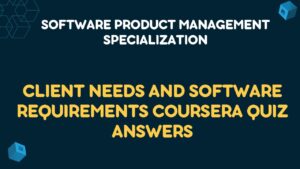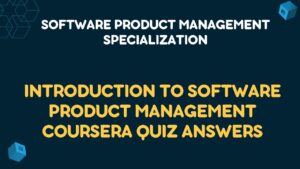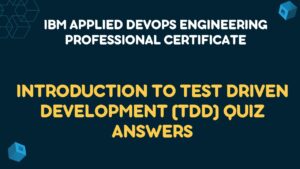Get All Weeks Version Control Coursera Quiz Answers
Table of Contents
Version Control Week 01 Quiz Answers
Quiz 1: Module 1 Assessment
Q1. Which one of these statements about Git is true?
Q2. Which one of these statements about branches is true?
ViewQ3. What is a request to merge your branch into another branch called?
ViewQ4. If a remote repository is offline, which one of the following is true?
ViewQ5. Which one of the following is true?
ViewQ6. Which one of these statements about commits is true?
ViewQ7. Which location contains the list of files that will be included in the next commit?
ViewQ8. Which location contains the commit history of a project?
ViewQ9. When a file is first placed in the working tree, what is its status?
ViewQ10. What must you do to add a new file to the next commit?
ViewQ11. If you create a local repository in a folder with existing files, what will be the status of the files?
ViewQ12. Immediately after you commit, where is the commit located?
ViewQ13. Which one of these statements about remote repositories is true?
ViewQ14. What is a local copy of a remote repository called?
ViewQ15. After you clone a repository, which one of the following is true?
ViewQ16. What is origin?
ViewQ17. What must you do to add a local commit to the remote repository?
ViewVersion Control Week 02 Quiz Answers
Quiz 1: Module 2 Assessment
Q1. In Git, what is modeled as a directed acyclic graph?
ViewQ2. How are Git commits connected?
ViewQ3. What is a Git ID?
ViewQ4. If a large file changes by one character, what would you expect to happen to its corresponding SHA-1 value?
ViewQ5. What do branch labels point to?
View.
Q6. How many HEAD references are in a local repository?
ViewQ7. Which one of these statements is correct?
ViewQ8. What happens when a branch is created?
ViewQ9. Which one of these statements is correct?
ViewQ10. What does a detached HEAD mean?
ViewQ11. What does “deleting a branch” immediately do?
ViewQ12. Which one of the following statements is true?
ViewQ13. Which one of the following statements about fast-forward merges is true?
ViewQ14. If Git informs you that a fast-forward merge is not possible, which one of these statements is most likely to be true?
ViewQ15. Which one of these statements about a merge involving a merge commit is true?
ViewVersion Control Week 03 Quiz Answers
Quiz 1: Module 3 Assessment
Q1. Which one of the following statements about merge conflicts is true?
ViewQ2. Assume that you have a topic branch merging into a base branch. Which one of the following is involved in resolving a merge conflict?
ViewQ3. Assume that you have a topic branch merging into a base branch. Which one of these situations is most likely to create a merge conflict?
ViewQ4. Which one of the following statements is true?
ViewQ5. Which one of the following is most likely to have tracking branches?
ViewQ6. Immediately after you clone a repository, which one of these statements is most likely to be true?
ViewQ7. If you perform a fetch and new objects are retrieved, which one of these is most likely to be true?
ViewQ8. Which one of these statements is true?
ViewQ9. Which one of these statements is true?
ViewQ10. A pull may result in which one of the following?
ViewQ11. When should you avoid rebasing a branch?
ViewQ12. Which one of the following statements is true?
ViewQ13. Which one of the following statements is true?
ViewQ14. Which one of the following statements is true?
ViewQ15. Which one of the following statements is true?
ViewVersion Control Week 04 Quiz Answers
Quiz 1: Module 4 Assessment
Q1. Which one of these is the main goal of a pull request?
ViewQ2. Which one of these statements is true?
ViewQ3. Which one of these statements is true?
ViewQ4. Which one of these statements is true?
ViewQ5. When can you open a pull request?
ViewQ6. Which one of these is true about squash merges?
ViewQ7. Which one of these statements is true?
ViewQ8. Which one of the statements about forks is true?
ViewQ9. After forking a repository, which one of these statements is true?
ViewQ10. Which one of these statements is true?
ViewQ11. Assume that you have a forked repository and an upstream repository. Who selects the merge strategy if a pull request is merged?
ViewQ12. Which one of these statements about centralized workflows is true?
ViewQ13. Which one of these statements about feature branch workflows is true?
ViewQ14. Which one of these statements about forking workflows is true?
ViewQ15. Which one of these statements about Gitflow workflows is true?
ViewGet All Course Quiz Answers of Machine Learning Specialization
Cryptography and Information Theory Quiz Answers
Symmetric Cryptography Coursera Quiz Answers
Asymmetric Cryptography and Key Management Quiz Answers
Cryptographic Hash and Integrity Protection Quiz Answers




